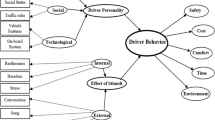Abstract
Automobile black boxes are devices that collect information regarding vehicle operation and the driver’s operating situation in the case of a traffic accident. The information collected from the automobile black box, which can also be used during normal driving, can provide information about dangerous driving cognition. This study was designed to analyze characteristics of dangerous driving data and build a dangerous driving cognition system as follows. First, dangerous driving is divided into four types by considering the vehicle’s movement, such as acceleration, deceleration, turning and statistical data of traffic accidents. Second, dangerous driving data were collected by vehicle tests using the automobile black box, and characteristics of the driving data were analyzed to classify dangerous driving. Third, a standard threshold was chosen to recognize dangerous driving, and an algorithm of dangerous driving cognition was created. Finally, verification was conducted by vehicle tests with automobile black boxes embedded with the developed algorithm. The presented recognition methods of dangerous driving can be used for on/off-line management of drivers and vehicles. Scientific traffic accident databases can be built with this driving and accident information, and can be used in various industrial areas.
Similar content being viewed by others
References
Alessandrini, A., Filippi, F., Orecchini, F. and Ortenzi, F. (2006). A new method for collecting vehicle behaviour in daily use for energy and environmental analysis. J. Automobile Engineering, Proc. Institution of Mechanical Engineers, Part D, 220, 1527–1537.
Chiou, Y.-C. (2006). An artificial neural network-based expert system for the appraisal of two-car crash accidents. Accident Analysis and Prevention, 38, 777–785.
eCall Driving Group (2006). Recommendations of the Driving Group eCall (DG eCall) for the introduction of the pan-European eCall. Safety Forum.
Gabler, H. C., Hampton, C. and Roston, T. (2003). Estimating crash severity: Can event data recorders replace crash reconstruction? Proc. 18th Int. Conf. Enhanced Safety of Vehicles.
Han, I. and Yang, K. (2007). Recognition of dangerous driving using automobile black boxes. J. Korea Society of Transportation 25,5, 149–160.
KATS Bureau of Technology & Standards Policy (2008). System for Accident Data Recording. KATS. KOR MKE.
Kowalick, T. M. (2005). Fatal Exit: The Automotive Black Box Debate. John Wiley and Sons. New Jersey.
Lee, W. and Han, I. (2004). Development and test of a motor vehicle event data recorder. J. Automobile Engineering, Proc. Institution of Mechanical Engineers, Part D, 218, 977–985.
Lee, Y. and Cho, J. (2007). Development of a safe driving management system. Trans. Korean Society of Automotive Engineers 15,1, 71–77.
Mundke, R. P., Arya, K. and Malewar, S. (2006). Use of data recorder for driver rating. SAE Paper No. 2006-01-0304.
MVEDR Committee (2004). IEEE Standard for Motor Vehicle Event Data Recorders (MVEDRs). IEEE.
NHTSA EDR Working Group (2006). Event Data Recorders-Final Rule. NHTSA, US DOT.
Niehoff, P., Gabler, H. C., Brophy, J. Chidester, A., Hinch, J. and Ragland, C. (2005). Evaluation of event data recorders in full systems crash tests. Proc. 19th Int. Conf. Enhanced.
Road Traffic Safety Authority (2002). Traffic Accident Statistics (in Korean). Seoul. Korea.
Road Traffic Safety Authority (2003). Traffic Accident Statistics (in Korean). Seoul. Korea.
Road Traffic Safety Authority (2004). Traffic Accident Statistics (in Korean). Seoul. Korea.
Road Traffic Safety Authority (2005). Traffic Accident Statistics (in Korean). Seoul. Korea.
Sa, J., Shung, N. and Sunwoo, M. (2003). Experimental analysis of driving pattern and fuel economy for passenger cars in seoul. Int. J. Automotive Technology 4,2, 101–108.
VEDI Technical Committee (2003). Vehicle Event Data Interface (VEDI)-Vehicular Output Data Definition-SAE J1698. SAE.
Author information
Authors and Affiliations
Corresponding author
Rights and permissions
About this article
Cite this article
Han, I., Yang, K.S. Characteristic analysis for cognition of dangerous driving using automobile black boxes. Int.J Automot. Technol. 10, 597–605 (2009). https://doi.org/10.1007/s12239-009-0070-9
Received:
Revised:
Published:
Issue Date:
DOI: https://doi.org/10.1007/s12239-009-0070-9




